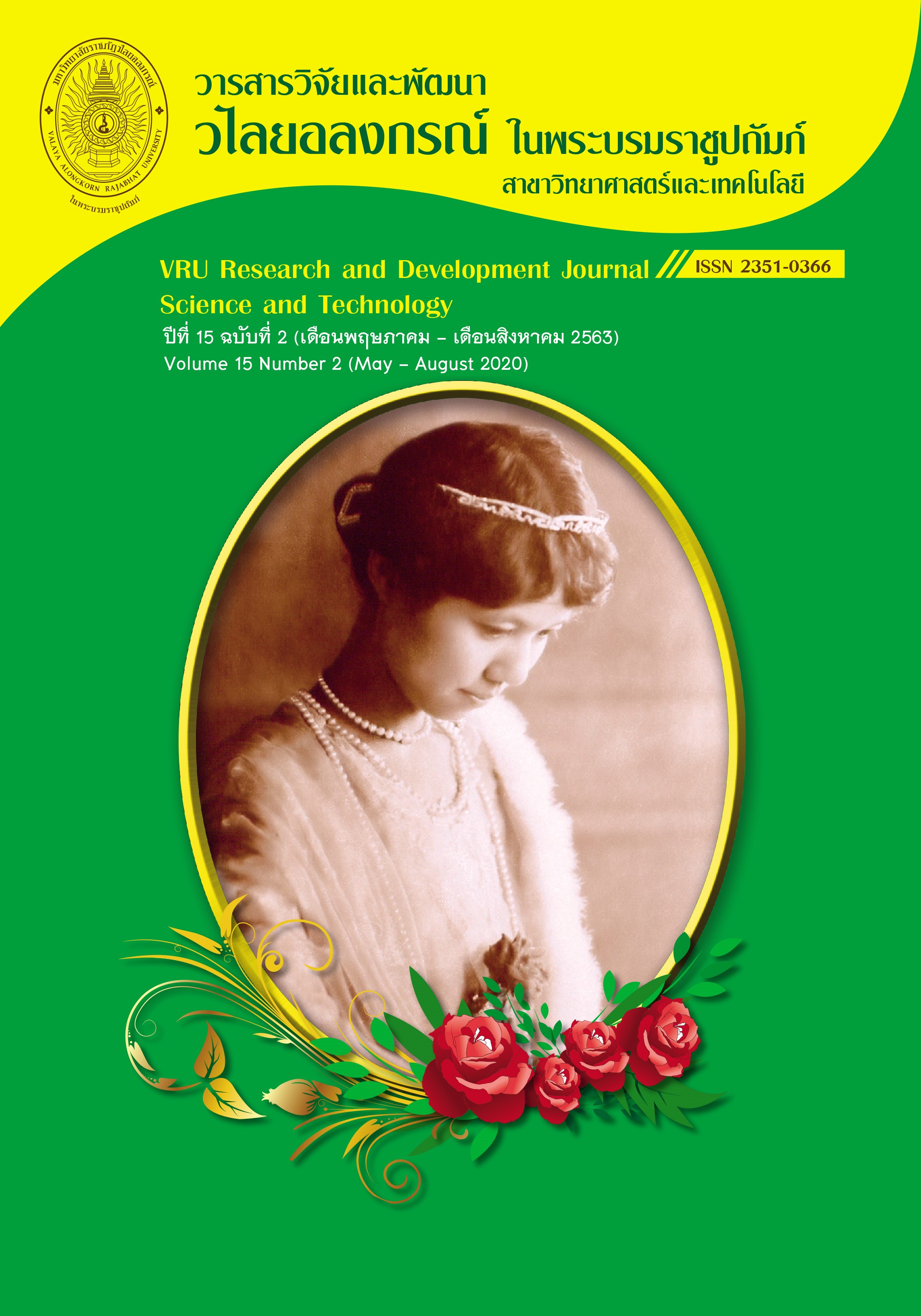THE EFFECTIVENESS OF SMALL RICE MILL MACHINE FOR RICE MILL OF RICE VARIETIES TRADING IN CHAI-NAT PROVINCE
Main Article Content
Abstract
This research was to find the efficiency of rice mill for rice varieties trading in Chai-Nat province by determining the optimum speed and the distance of gaps the rubber roller to appropriate of each varieties rice. In the experiments, three rice varieties were selected: Chai-Nat1 Rice, Rice berry and Thai Pathumthani Fragrant Rice from Ban Hua-Ta-phan Community, Sankhaburi District, Chai-Nat Province. The experiment used one kilogram of rice per time by controlling paddy has a 15 percent moisture content. After that, adjusted the speed of motor at 30-50 Hz and adjusting the distance of gaps the rubber roller to match of each varieties rice. The results of the experiment showed the optimum speed of Chai-Nat1 Rice, surface speed of rubber rollers A, B and C was 1,009.0, 590.3 and 1,019.0 rpm, respectively. Rice berry, surface speed of rubber rollers A, B and C was 1,110.3, 649.9, and 1,123.7 rpm, respectively. Thai Pathumthani Fragrant Rice, the surface speed of the rubber rollers was 861.8, 503.9 and 870.2 rpm, respectively. Thai Pathumthani Fragrant Rice, Gap between the rubber rollers is one millimeter. Rice berry and Chai-Nat1 Rice, Gaps between the rubber rollers is 0.9 millimeter. Therefore, the efficiency test results of the small rice mill showed that Chai-Nat 1received white rice, equivalent to 65percent of the weight of the paddy. In Rice berry obtained brown rice equal to 76 percent of the weight of the paddy and Thai Pathumthani Fragrant Rice obtained white rice, representing 75 percent of the weight of the paddy. The results of comparing the three types showed that adjust speed and the distance of gaps the rubber roller to appropriate of each varieties rice that resulted in receiving less broken white rice. The results of milling of Thai Pathumthani Fragrant Rice were more white rice than Chai-Nat 1, and for Rice berry milling could be done only once, instead of having to repeat rice milling twice, and the results of brown rice color were very satisfactory.
Downloads
Article Details
Copyright Notice
The copyright of research articles published in the VRU Research and Development Journal Science and Technology Journal belongs to the Research and Development Institute, Valaya Alongkorn Rajabhat University under the Royal Patronage. Reproduction of the content, in whole or in part, is prohibited without prior written permission from the university.
Responsibility
The content published in the VRU Research and Development Journal Science and Technology Journal is the sole responsibility of the author(s). The journal does not assume responsibility for errors arising from the printing process.
References
จักรกฤษณ์ เคลือบวงศ์, อรัญ ตาเขียว, สุรวุฒิ รุ่งสว่าง, และกาญจนา ท้าวบุตร. (2557). การพัฒนาเครื่องสีข้าวขนาดเล็กด้วยโปรแกรมเมเบิ้ลลอจิกคอนโทรล. ปริญญานิพนธ์ วิศวกรรมศาสตรบัณฑิต คณะวิศวกรรมศาสตร์, มหาวิทยาลัยเทคโนโลยีราชมงคลล้านนา.
ธนัสถ์ นนทพุทธ, กรภัทร เฉลิมวงศ์, ศักดิ์ชัย ตันติวิวัทน์, และณชพร รัตนาภรณ์. (2558). เครื่องสีข้าวกล้องขนาดเล็กสำหรับครัวเรือน, วารสารวิชาการและวิจัย มทร.พระนคร. (ฉบับพิเศษ), 489-498.
นิทัศน์ ตั้งพินิจกุล, อารีย์ ทิมินกุล และวิบูลย์ เทเพนทร์. (2548). เครื่องสีข้าวขนาดเล็ก. สืบค้นจาก http://www.doa.go.th/aeri/?p=884
สมาคมโรงสีข้าวไทย. (2561). สรุปรายงานราคาข้าวสารและราคาข้าวเปลือกเฉลี่ยแต่ละเดือนประจำปี 2561 ของสมาคมโรงสีข้าวไทย. สืบค้นจาก www.thairicemillers.org
สุรพงศ์ บางพาน, และพีรพันธ์ บางพาน. (2555). เครื่องสีข้าวขนาดเล็กแบบเปิด. การประชุมวิชาการสมาคมวิศวกรรมเกษตรแห่งประเทศไทย ครั้งที่ 13, 4-5 เมษายน 2555 โรงแรมอิมพีเรียล แม่ปิง. เชียงใหม่: คณะวิศวกรรมศาสตร์ มหาวิทยาลัยเชียงใหม่.
สุรินทร์ แหงมงาม, ศศิวรรณ อินทรวงศ์, ธีรวัฒน์ แม้นพวก, ธนาวุฒิ ชินบุตร, อนาวิน กรรณแก้ว, และภูมิใจ เหล่าผง. (2558). เครื่องสีข้าวขนาดเล็กสำหรับใช้ในครัวเรือน. การประชุมสัมมนาเชิงวิชาการรูปแบบพลังงานทดแทนสู่ชุมชนแห่งประเทศไทย ครั้งที่ 8, 4-6 พฤศจิกายน 2558 คณะวิศวกรรมศาสตร์ มหาวิทยาลัยเทคโนโลยีราชมงคลธัญบุรี.ปทุมธานี: คณะวิศวกรรมศาสตร์ มหาวิทยาลัยเทคโนโลยีราชมงคลธัญบุรี.
สำนักงานเศรษฐกิจการเกษตร. (2559). ผลการผลิตข้าวแยกตามจังหวัดปี พ.ศ.2559. สืบค้นจาก http://mis-app.oae.go.th


